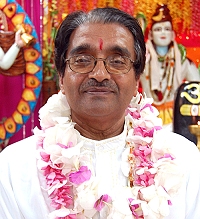From a discourse with Paramacharya of SWAHA, H.H. Pt. Hardeo Persad
From age to age, the Supreme Brahman manifests on earth for various reasons. Chapter 4, verses 7 and 8 of Srimad Bhagwad Gita outlines the chief causes of His manifestation. These are:
1) The protection of the virtuous
2) To destroy unrighteousness
3) For the restoration of righteousness
In the age of Dwaapar, Shri Krishna appeared on earth to fulfil these divine objectives, thereby sustaining the world. This form of the Divine, the eighth major manifestation of Lord Vishnu is Vyuha Avataar, a transcendental emanation where the Lord exercises different cosmic functions and controls the activities of living beings.
He is also considered to be Purna Avataar, the one who is complete. As Leela Avataar, the Lord came to perform the dramas on the world’s stage so man could elicit the many lessons of spiritual evolution, as he progresses on the road to self-realization.
According to Shri Bhagwat Puraan, a Hindu scriptural text, Shri Krishna appeared in the city of Mathura, as the child of Devaki and Vasudev. He was transported across the river Yamuna to the village of Gokula, to the home of Yashoda and Nand who became His foster parents. Growing up in a rustic village among cowherd families, the child Krishna performed countless leelas or transcendental pastimes on the world’s stage. These leelas created ecstasy in the hearts of the pure and devoted residents with whom he interacted.
At the same time, He used every opportunity to fulfil His mission of destroying unrighteousness, of protecting His devotees and championing their cause. He brought an end to the reign of evil that was perpetuated by the evil King Kans and his cohorts. With the end of Kans at the hands of Bhagavan Krishna, Vasudev was handed rulership of the state and righteousness replaced evil.
Shri Krishna made an indelible impression upon man’s consciousness. He is the central figure in Srimad Bhagwad Gita, in which He educates the world on one’s duty and other facets of a righteous life. He guides man on the path of spiritual progress. His example on earth is a model for individuals of all walks of life, the modern world and surely for those in ages to come.
More than a mere allegory, the scriptural episode that outlines the Divine’s manifestation and time on earth, has deep metaphysical implications. It bears much relevance to our lives and empowers us to achieve our true purpose of self-realization.
A brief outline of some of these symbolical representations is as follows:
Shri Krishna – the essence of the Vedas; cosmic harmony
Devaki – the cosmic embryo; the manifestation of Om; a representation of the five-fold functions of Brahman
Vasudev – Vedic literature
Nand – delight borne out of Supreme Bliss
Yashoda – ultimate state of bliss born out of Supreme Delight
Mathura – the abode of wisdom
Kans – the age of strife, wickedness and evil
Gokula – heaven where Shri Krishna sports, a veritable paradise
Yamuna – the stream of karma or disinterested action
Cows – thousands of verses that are in the Vedas
As the Hindu world celebrates the auspicious occasion of Gita Jayanti on December 3, 2022, it is hoped that everyone who celebrates this most auspicious scripture, Srimad Bhagwad Gita, would be drawn closer to the experience of cosmic harmony, born from delight and divine ecstasy.



